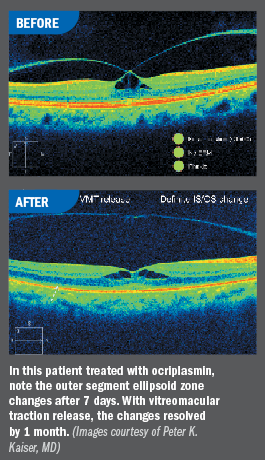Article
Real-world experience provides new insights on ocriplasmin
Real-world experience with ocriplasmin (Jetrea, ThromboGenics) show that the treatment success rate can be increased by appropriate patient selection.
TAKE-HOME
Real-world experience with ocriplasmin (Jetrea, ThromboGenics) shows that the treatment success rate can be increased by appropriate patient selection.

Dr. Kaiser
Reviewed by Peter K. Kaiser, MD
Cleveland-Real-world outcomes in patients treated with intravitreal ocriplasmin (Jetrea, ThromboGenics) for symptomatic vitreomacular adhesion (sVMA) corroborate information from the pivotal clinical trials on factors predicting success and point to early development of ellipsoid zone changes as another prognostic marker, according to Peter K. Kaiser, MD.
A post-hoc analysis of data in the ocriplasmin pivotal trials determined that VMA diameter ≤1,500 µm, phakic lens status, age <65 years, presence of a full thickness macular hole, and absence of an epiretinal membrane were independently associated with VMA resolution. Therefore, in clinical practice, many retinal specialists have been using those parameters to guide patient selection for ocriplasmin injection, explained Dr. Kaiser, Chaney Family Endowed Chair in Ophthalmology Research, Cole Eye Institute, Cleveland Clinic, Cleveland.
Analyses of data from patients treated at the Cole Eye Institute and other centers using that approach show its value for increasing treatment success. Whereas 26% of patients treated with ocriplasmin in the phase 3 studies achieved nonsurgical resolution of VMA, a success rate of about 50% is being achieved at real-world sites, Dr. Kaiser said.
“Interestingly and importantly, the success rate with ocriplasmin appears to be essentially the same in large retina centers across the country, whether they represent academic institutions or are in a community practice setting,” he said.
“These data validate the idea that with selection of appropriate candidates, retinal specialists can expect to achieve success in about half of patients they treat with ocriplasmin, which is much better than the primary outcome reported in the pivotal clinical trial,” Dr. Kaiser said.

New prognostic factor
An association between early disappearance of the outer segment (OS) ellipsoid zone and positive anatomic outcomes was also identified in the analysis of data collected at the Cole Eye Institute and corroborated by findings from other centers.
Dr. Kaiser noted that when patients treated at his center were imaged at 1 week post-injection using spectral-domain OCT, around 40% had developed this loss of the inner segment-outer segment junction. Within the subgroup of eyes with OS ellipsoid zone changes, about 75% also achieved vitreomacular traction (VMT) release indicating that the two may be related.
In the analysis, all the eyes with OS ellipsoid zone changes normalized by about 1 month, and their temporal course appears to correspond to the appearance and resolution of various adverse events seen in the clinical trials, including dyschromatopsia, electroretinogram changes, acute decrease in visual acuity, and even impaired pupillary reflex, Dr. Kaiser said.
“The disappearance of the OS ellipsoid zone provides an anatomic correlate for the visual symptoms some ocriplasmin-treated patients were experiencing,” he said. “It is unclear whether the OS ellipsoid zone change represents a metabolic or toxic effect of the treatment, but that is the most likely explanation.
“Importantly, however, it does not appear to be a cause for alarm,” he said. “Not only is the change temporary, but it seems to be a favorable development that is a proxy for treatment success.”
He noted that at the 2014 meeting of the Association for Research in Vision and Ophthalmology, three other large retina groups reported similar findings regarding the OS ellipsoid zone changes.
“It was striking that the collective data from the three other groups were nearly identical to ours in terms of the percentage of patients who developed the change in the OS ellipsoid zone (mean of 42%) and the percentage of those individuals who achieved VMT release (mean of 77%). Similar to our experience as well, the OS ellipsoid zone changes normalized by 1 month in 100% of eyes in two series that had sufficiently long follow-up, and in 81% in the other series that had very short follow up,” Dr. Kaiser said, adding that the outer retinal changes is a subject for further investigation in ongoing phase IV studies.
Peter K. Kaiser, MD
Dr. Kaiser is a consultant for Alcon Laboratories, Allegro, Novartis, and ThromboGenics.
Newsletter
Don’t miss out—get Ophthalmology Times updates on the latest clinical advancements and expert interviews, straight to your inbox.




